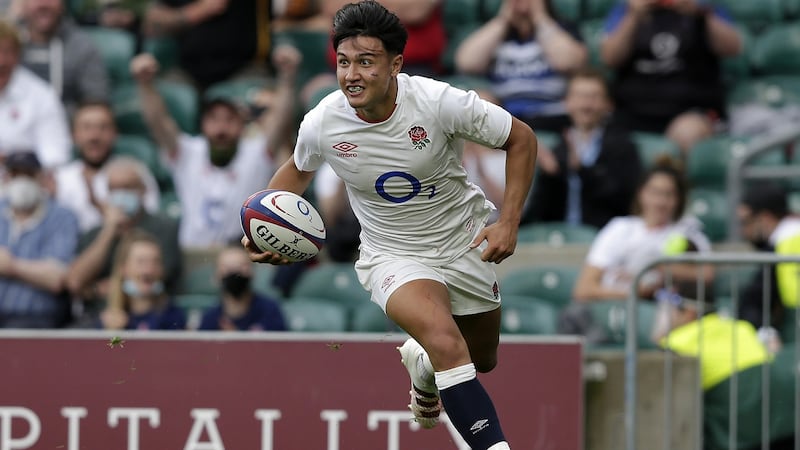Across time, in different parts of the rugby world, those wearing the number 10 jersey have been called many names. First five eighths, flyhalves, outhalves, five eighths and standoff halves. The French call their number 10 ‘demi de overture’, which can literally mean ‘half opening’.
The name of the number 10 may have changed but the importance of their role within the teams has only grown within the game.
Historically, most of those brave enough to take on the responsibility of wearing number 10 have fallen into one of two camps. The majestic kickers of the rugby ball, who could shape the ball with both feet so brilliantly that they would slice and dice your defence with the laser-like accuracy of their boots.
Giant names like Ollie Campbell, Grant Fox, Naas Botha, Johnny Wilkinson, Ronan O'Gara, Hugo Porter, Neil Jenkins and Andrew Mehrtens were so highly skilled in controlling a rugby ball with their feet that they would force opposing teams to play most of the game 20 metres from their own try line.
The other camp is populated by the passers, runners and creators. The genius of Mark Ella, who remains the greatest player I have ever seen, tops my list but it would be impossible not to argue for the creative brilliance of Barry John, Phil Bennett, Stephen Larkham, Carlos Spencer and while it is more than 70 years ago, the brilliance of Ireland's own Jackie Kyle, as recorded in history and on film, cannot be ignored.
Of course, there were many wonderful outhalves that could run, pass and kick with equal brilliance. Johnny Sexton has his name etched close to the top of this list as does the majestic Michael Lynagh, Didier Camberabero, Tony Ward and Dan Carter.
In the professional era, New Zealand have produced the richest linage of first five eighths as the Kiwis call them. From Carlos Spencer to Carter, Aaron Cruden then Beauden Barrett followed by Richie Mo'unga, the Kiwis have had a production line of lightning fast, intelligent, creative first fives.
Today in the north there is a flush of talented running number 10s. Romain Ntamack tops the list, followed by Finn Russell, Marcus Smith and Italy's Paolo Garbisi. All are positive, ball-in-hand players, who are fast, confident, unpredictable and creative.
Sexton remains the iconic outhalf in the northern hemisphere. Last November, with his forwards laying down a solid platform of go-forward from their excellent ball carrying, rugby's Tom Brady turned in one of his all-time best performances in defeating New Zealand.

Yet for Eddie Jones, the most experienced head coach in the championship, to leave the obvious creative talents of Smith unsupported on the field is not part of his plan.
Before fate intervened and Owen Farrell was injured, Jones had planned to have Farrell as Smith's on-field mentor. A steady voice, calmly talking in Smith's inexperienced ear. Instead, the mercurial Henry Slade has been moved from outside to inside centre, with the added responsibility of guiding Smith through his first Six Nations campaign.
This is not a new idea but one that Jones has witnessed successfully at first hand. Eddie played a lot of his rugby alongside Lloyd Walker, the great indigenous Australian inside centre. For Randwick and the Wallabies, Walker guided his outhalves, including the great Mark Ella, through matches. Taking pressure off his five eighths in both attack and defence with advice, options and actions.
Jones learned how a mature, wise inside centre can empower their outhalves to play with more instinct and freedom simply by taking some of the decision-making pressure from the shoulders of their talented, but sometimes information overwhelmed 10s.
Phil Bennett had the great of Ray Gravel and Steve Fenwick outside him. In the legendary 1984 Grand Slam Tour, Ella had the calm genius of Lynagh on his shoulder at 12, while Carter had the comfort of Ma'a Nonu's power and Conrad Smith's wisdom.
It is no accident that in Ireland's last two Grand Slams Ronan O'Gara had the vast experience of Gordon D'Arcy and Brian O'Driscoll as consigliere in 2009, and in 2018 Sexton had the world's leading inside centre, Robbie Henshaw, as his lieutenant, providing high-quality options to accompany Sexton's brilliance.
In a well structured backline inside centres are not only key generals in the attack. Many teams use their number 12s as the cornerstone of their defensive structure. Once again, the idea is to take pressure away from the outhalves and for the inside centre to shoulder the defensive leadership within the team.
Titles are important and the New Zealand call their inside centres second five eighths. They act as the secondary key decision-makers in the team. Ryan Crotty personified the Kiwis' thinking in this area.
Last weekend, during the NFL Divisional playoffs, Troy Aikman, a hall of fame quarterback, was calling the Chiefs v Rams game for TV. He was asked what he considered would be the key determining factor in the match. He simply said: "The individual brilliance of the two quarterbacks."
This Six Nations may come down to a similar shoot-out of who has the best outhalf, but like most things in rugby, it's more complicated than that.
It is a fact that the NFL quarterbacks and rugby’s five eighths have evolved from the same ancient rugby ancestor. A major difference is that in today’s NFL the quarterbacks have the plays relayed to them via radio from the offensive coordinator’s box, high up in the stand. Rugby’s outhalves do not have that luxury. In the white hot heat of physical confrontation with 80,000 roaring supporters, it is the players alone who have to make the crucial decisions and call the next play.
High quality experienced inside centres, confidently suggesting options to his outhalf, can be the difference between a match-winning decision and a flustered choice.
Farrell's injury is a great blow to England and his excellent leadership will be missed, especially in guiding the undoubted talents of Smith around the park.
I do not know if any inside centre ever born could deter Finn Russell from a decision once he has set his mind to it, but it is something he desperately needs. A calm head, guiding his team around the park is far more productive than a rash grab at a 40-metre drop goal, as he attempted in the 79th minute at Twickenham last year when Scotland were clinging to a slender lead.
Without more guidance and game management Russell’s highly skilled raw talent may not be enough to lead Scotland to victory.
There is only one demi de overture in the championship. Ntamack holds some powerful cards in his hand. He has World Rugby's player of the year, Antoine Dupont, inside him at scrumhalf and Gael Fickou, who was outstanding at inside centre for France in last year's tournament, on his outside.
Playing between these two brilliantly talented leaders may be the environment that can accelerate the flourishing of Ntamack’s wonderful talents and bring his game to new level. Which is wonderful for France and a nightmare for the rest.
While the actions of this talented generation of outhalves will have a great impact on this year’s Six Nations, the championship may very well be decided by the team whose collective onfield generals make the best key decisions.














